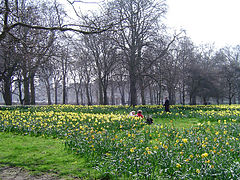Green Park
| Green Park | |
|---|---|
 | |
| Type | Public park |
| Location | London, SW1 United Kingdom |
| Coordinates | 51°30′15″N 0°08′37″W / 51.50417°N 0.14361°W |
| Area | 19 hectares (47 acres) |
| Operated by | The Royal Parks |
| Public transit access | |
| Website | www |
The Green Park, usually known without the definite article simply as Green Park, is one of the Royal Parks of London. It is located in the City of Westminster, Central London. First enclosed in 16th century, it was landscaped in 1820 and is notable among central London parks for having no lakes or buildings, and only minimal flower planting in the form of naturalised narcissus.
Description and surroundings
Green Park covers just over 40 acres (16 ha)[1] between Hyde Park and St. James's Park. Together with Kensington Gardens and the gardens of Buckingham Palace, these parks form an almost unbroken stretch of open land reaching from Whitehall and Victoria station to Kensington and Notting Hill.
In contrast with its neighbouring parks, Green Park has no lakes, no buildings, no playgrounds, and few monuments, having only the Canada Memorial by Pierre Granche, the Diana of the Treetops Fountain by Estcourt J Clack[2], and the RAF Bomber Command Memorial by Philip Jackson. The park consists almost entirely of mature trees rising out of turf; the only flowers are naturalised narcissus.
The park is bounded on the south by Constitution Hill, on the east by the pedestrian Queen's Walk, and on the north by Piccadilly. It meets St. James's Park at Queen's Gardens with the Victoria Memorial at its centre, opposite the entrance to Buckingham Palace. To the south is the ceremonial avenue of the Mall, and the buildings of St James's Palace and Clarence House overlook the park to the east. Green Park Underground station is a major interchange located on Piccadilly, Victoria and Jubilee lines near the north end of Queen's Walk. Tyburn stream runs beneath Green Park.[3]
History
The park is said to have originally been swampy burial ground for lepers from the nearby hospital at St James's. It was first enclosed in 16th century when it formed part of the estate of Poulteney family. In 1668, an area of the Poulteney estate known as Sandpit Field was surrendered to Charles II, who made the bulk of the land into a Royal Park as "Upper St James's Park" and enclosed it with a brick wall.[4] He laid out the park's main walks and built an icehouse there to supply him with ice for cooling drinks in summer.
The Queen's Walk was laid out for George II's queen Caroline; it led to the reservoir that held drinking water for St James's Palace, called the Queen's Basin.[5]
At the time, the park was on the outskirts of London and remained an isolated area well into the 18th century, when it was known as a haunt of highwaymen and thieves. Prime Minister Horace Walpole was one of many to be robbed there.[6] During the 18th and 19th centuries, it was a popular place for ballooning attempts and public firework displays; Handel's Music for the Royal Fireworks was composed specifically for a fireworks celebration held in The Green Park in 1749.[7] The park was also known as a duelling ground; one particularly notorious duel took place there in 1730 between William Pulteney, 1st Earl of Bath and John Hervey, 1st Earl of Bristol.[8]
In 1820, John Nash landscaped the park, as an adjunct to St. James's Park.[9] On 10 June 1840, it was the scene of Edward Oxford's assassination attempt on Queen Victoria, on Constitution Hill.
Gallery
-
Green Park and Constitution Hill
-
Green Park, London
-
Canada Gate, located on the south side of the park
-
Green Park and St. James's Park c.1833
-
Buckingham Palace, as seen from Green Park
References
- ^ "The Green Park". The Royal Parks. Retrieved 2 December 2018.
- ^ "E J Clack to Move Centre Stage at Green Park Station". www.peterberthoud.co.uk. Retrieved 8 January 2020.
- ^ Royal Parks website: The Green Park
- ^ 'The Bailiwick of St. James', Survey of London: volumes 29 and 30: St James Westminster, Part 1 (1960), pp. 21–28. URL: http://www.british-history.ac.uk/report.aspx?compid=40542. Date accessed: 29 January 2008.
- ^ "Landscape History – Green Park – The Royal favourite". The Royal Parks. Retrieved 1 June 2015.
- ^ "Green Park". The Encyclopedia of London, eds. Ben Weinreb, Christopher Hibbert. Macmillan, 1992.
- ^ "Fireworks Music" The Concise Oxford Dictionary of Music. Michael Kennedy. Oxford University Press, 2007.
- ^ London: what to see, and how to see it, p. 61. H.G. Clarke, 1862.
- ^ "Landscape History". The Royal Parks. Retrieved 9 October 2018.








